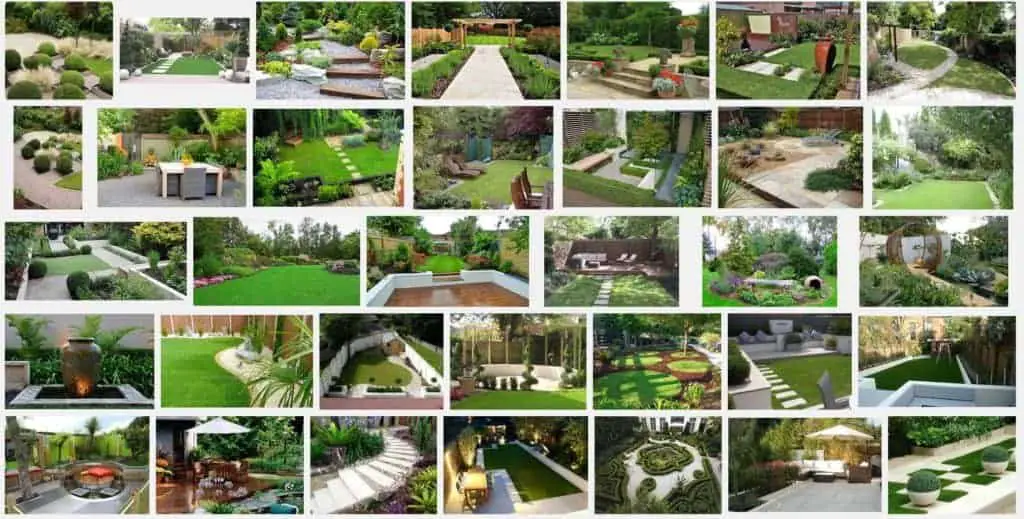This post is an introduction to a short series on using images as inspiration for your garden design. Each post will focus on one key ‘tip’ to make you more aware of what you ‘don’t know’ about the context of the image, and how that can have a big influence on how you use the image to generate your own ideas and plans for your garden or backyard.
Sick of looking at your drab, boring, tired, messy, looks-like-a-bomb-hit-it garden or backyard? The internet is overflowing with garden design ideas, tips, tricks and solutions suitable for every person in every possible context.
Unfortunately, many images are about as useful to the budding designer and backyard DIYer as a pair of heels at a boot camp. They’re pretty to look at, but completely impractical and likely to cause you pain and suffering if used incorrectly.
So millions of people spend thousands of hours wading through this garden design porn. They sift through sites like Pinterest, Facebook, Houzz and Instagram – not to mention the usual magazine sites or blogs.
They waste time dreaming about what could happen rather than making it happen.
Images can be incredibly useful – a great motivator for action. But only IF they are used CORRECTLY, and their context is UNDERSTOOD.
To make progress with your backyard garden you need to use images in a way that helps you choose what you like and combine it with your environment.
To take something practical from photos and images, you have to understand one EXTREMELY important rule every time you look at something new:
CONTEXT IS EVERYTHING
So… what does this mean? Context refers to all the details that influenced how that image came to be created.
This covers:
- The location of the garden (known as the site)
- The people involved (contractors and clients)
- How the image was developed and manipulated.
So you get sucked down the rabbit hole, stumbling across image after image of beautiful, seductive, (expensive) photos (of garden designs…).
Soon you find something you might be able to convince your partner to try in your own garden or backyard (again, design…).
‘Context is Everything’ is my personal motto. Not just in design, but life in general.
Environment (physical, emotional or otherwise) influences decisions and outcomes. Without understanding this context, it’s difficult to grasp how a decision or outcome was reached. If you can’t understand it, or the forces that shaped it, you can’t really judge it (or recreate it).

Designed by Studio Dwell Architects/ Julie deLeon. Photo by Marty Peters Photography
Before filing it away in the ‘one day’ folder, you will convince yourself you could recreate it in your garden. Change something here, add something there and you’re good to go.
Unfortunately things are never quite that simple.
You don’t know the context around the image; who was involved; where it is located; and how the design, garden and photo were developed.
Planning something similar to this image without understanding the context can cause many problems.
Most people copy and paste ideas into their gardens one at a time. They are gathered and implemented with no thought given to an overall design. This is how you end up with dead garden beds, half-finished projects and chaos when looking out your window.
CONTEXT SHAPES DESIGN
If you get how context shapes and informs a design, you will be in a much better position when looking at photos.
You can make decisions about what can and can’t work and begin to see similarities and differences between your garden and theirs.
Understand the image you are viewing is a single snapshot of a story. Knowing this, you can develop a flexible design that is easy to change.
Once you understand those relationships, you can; ask more specific questions; make more informed decisions; and see and create short-cuts.
Then you can take your idea from a dream to a reality.
To give you a better idea of understanding the context of an image, I’ve broken it down into 4 key ‘tips’:
- Site Conditions and Climate
- Clients
- Design and Construction Process
- The Image Itself
The viewer rarely considers these – and the author never discusses them. They’re better left unsaid so viewers assume it is an easy process. Then it seems like something they can simply copy and paste into their garden.
As a result you spend all your time just looking at images. While you dream of placing them in your garden, you never get around to it.
I will go in depth in a series of posts to follow. I’ll break down the details you NEED to think about when looking at an image. This will help turn the images in your ‘one day’ folder into a design for your backyard garden.
TAKE ACTION: FIND AN IMAGE YOU WOULD LOVE TO REPLICATE IN YOUR GARDEN
You can focus on a small portion of it or the whole image. In the next few posts, we will go through each tip in greater detail.
You can work through each point and see how they apply to your image. You will learn more about the similarities and differences between your dream and their reality.
Also, find an image that EXCITES YOU! If you want to create your dream garden, start with big dreams!



Matt, your videos are genuinely the most helpful I’ve seen for a homeowner/designer! We’ve landscaped our yard 3 times, working with designers each time and we still have an unattractive, largely unusable space. But after watching your videos, for the first time, I feel like I have a process I can follow and am really engaged, instead of overwhelmed. I’ve taken a notebook load of notes from your vids, and was hoping to find your guides online as well.
Thanks so much for this rich content! You need a wider audience because it is really brilliant.
Best Regards,
Lily Baker
San Jose, California